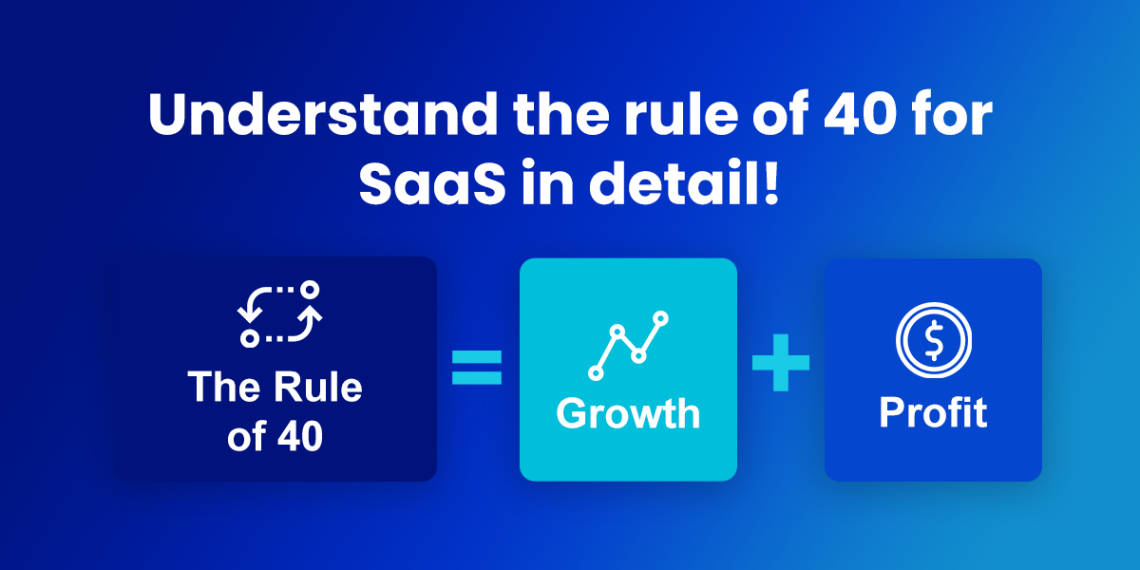The rule of 40 is a metric used to evaluate the performance of software-as-a-service (SaaS) companies. It is a widely recognized benchmark in the SaaS industry that helps to assess the balance between a company’s revenue growth and profitability. In essence, The rule of 40 states that the sum of a SaaS company’s growth rate and gross margin should be around 40%.
What is the rule of 40, and what is its significance?
The significance of the rule of 40 lies in the fact that it provides a comprehensive way to evaluate a SaaS company’s financial health. In the early stages of a SaaS company’s growth, revenue growth is often prioritized over profitability. As the company matures, it becomes increasingly important to focus on profitability in order to ensure long-term sustainability. The rule of 40 helps balance the pursuit of revenue growth with the need for profitability, ensuring that a SaaS company is growing at a healthy pace while maintaining a solid gross margin.
Investors, analysts, and entrepreneurs use the rule of 40 as a critical metric to assess the potential of a SaaS business.
A company that exceeds the rule of 40 is generally seen as a more attractive investment opportunity, as it has a strong balance between growth and profitability. On the other hand, a SaaS company that falls below the rule of 40 may struggle to secure investment, as investors may be wary of its lack of profitability and sustainability.
In addition to its use as a performance metric, the rule of 40 also serves as a useful benchmark for SaaS companies. By comparing their growth rate and gross margin to the rule of 40, SaaS companies can gain insight into how they perform relative to their industry peers. This can help them identify areas for improvement and make strategic decisions that will drive long-term growth and profitability.
It is important to note that the rule of 40 is not hard and fast, and there may be exceptions for certain SaaS companies. For example, a SaaS company in the early stages of growth may prioritize revenue growth over profitability and, therefore, fall below the rule of 40.
In these cases, it is important to assess the company’s performance in the context of its growth stage and its overall business strategy.
How is the rule of 40 for SaaS calculated?
The calculation of the rule of 40 is straightforward. To determine if a SaaS company meets the rule of 40, simply add its growth rate and gross margin. If the sum is around 40%, the company is considered to be in good financial health. If the sum is significantly above or below 40%, it may indicate that the company needs to adjust its focus on revenue growth or profitability.
What are the benefits of the rule of 40?
- By using the rule of 40, SaaS companies can make informed decisions for long-term growth and profitability and ensure their continued success in the dynamic and competitive SaaS industry.
- The rule of 40 is an essential concept for all software-as-a-service (SaaS) companies, as it measures the company’s overall health. The rule of 40 is based on the idea that a company should have a combined growth rate and profit margin of 40% or more. This means that if a SaaS company has a 20% growth rate and a 20% profit margin, it is considered healthy.
- The rule of 40 is important for SaaS companies because it indicates the company’s success. A company with a high growth rate and a high-profit margin indicates that it is likely doing well in terms of sales and customer satisfaction. This is a sign of a strong product and a healthy business model. On the other hand, a company with a low growth rate and a low-profit margin may be struggling to attract and retain customers, which could indicate a product that is not meeting customer needs.
- The rule of 40 also helps SaaS companies determine the suitable pricing model for their products. Companies with a high growth rate and high-profit margin may be able to offer their products at a premium, while those with lower growth and profit margins may need to offer discounts or other incentives to attract customers. This helps companies ensure that they are able to maximize their profits while still providing customers with good value.
- Finally, the rule of 40 helps SaaS companies to plan for future growth. Companies with a high growth rate and a high-profit margin can use this information to plan for future investments, such as expanding their product offerings or expanding into new markets. This can help them stay ahead of the competition and ensure that they are able to capitalize on new opportunities.
In conclusion, the rule of 40 is an essential concept for SaaS companies, as it indicates the company’s overall health and helps them determine the suitable pricing model and plan for future growth. By following the rule of 40, SaaS companies can ensure that they are able to maximize their profits and remain successful in the long term.







